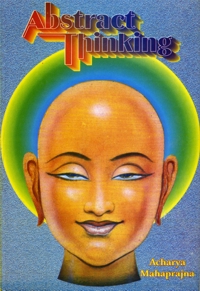
The principle of like and unlike is of the essence of the reality of a thing. Thus, no realistic view can be one-sided, altogether unrelated and absolute.
Lord Mahavira propounded the doctrine of synthesis between both the spheres - of thought and of conduct. In the sphere of thought, not only has that tradition been preserved, but also further developed. But in the sphere of conduct, the tradition has sunk into oblivion; it has been even neglected.
Haridhadra Suri acquainted the philosophical world with the power of the doctrine of synthesis by including atheists in the forum of philosophers. The theistic philosophies did not visualize such inclusion. But Haribhadra realized this possibility.
The question came up before Upadhyaya Yashovijay as to who is a theist and who an atheist? He looked at it in the context of relativism and said: "No one is wholly an atheist or wholly a theist. Charwak does not recognize the soul. And if he is considered to be an atheist, should not the phenomenal world, be considered as atheist, too? And if the absolutist philosophies which recognize the essential elements are considered to be theistic how can we say that Charwak, who recognizes the elements like earth, etc., is not a theist?"
Acharya Akalanka said: "The soul, in the context of the element of consciousness, is a soul: but it is not a soul in the context of other elements. Both the soul and the non-soul are not lacking in similar elements."
The Acharyas like Siddhasen, Samantbhadra, Akalanka, Haribhadra, Hemchandra, etc. have so developed the tradition of synthesis, as to render the ocean of Jain philosophy capable of absorbing all streams of thought.
The monism of Vedanta has become the sangraha-naya of Jain philosophy. The materialistic point-of-view of Charwak finds expression in vyavahara naya.
The Paryayavada of the Buddhists may be said to be the Rijusutra naya of Jain philosophy. Vyakaranon ka shabdadvaita is the shabdanaya of Jain philosophy.
Jain philosophy has accepted the truth of all viewpoints - with one condition. That condition is that all these points-of-view, provided they are strung together with the thread of relativity, are true. But if these various viewpoints are exclusively concerned with their own truth, attacking the very existence of others, they are untrue. The understanding of the principle of synthesis, of relativity, is the understanding of truth. The exposition of the principle of synthesis is the exposition of truth. Truth is infinite and neither a single viewpoint can encompass it nor a single word expounds it.
In the context of the doctrine of relativity a question arises as to whether Mahavira's philosophy is the outcome of a synthesis of all philosophical viewpoints or whether it is an original creation of his own.
Two epithets are applied to Mahavira - all-knowing and all-seeing. He knew all and he saw all. He expounded his philosophy on the basis of omniscience and omni-viewing. Its fundamental character is this that every substance has infinite qualities and each quality is allied with its opposite. Every substance contains within itself unlimited pairs of opposites. This doctrine has not emerged out of a synthesis of various viewpoints. However, the philosophy of relativity or coordination has resulted from this doctrine, but the acceptance and propounding of the simultaneous existence of an unlimited number of pairs of opposites in any one substance.
The general and the particular-both these are the characteristics of a substance. Therefore, the man who comprehends what Mahavira says can neither support nor oppose the generalisation of Vadanta or the particularisation of Buddhism. He perceives an association, a„ harmony between the two. When turning our back on the modes, we concentrate our attention on the substance. We perceive the general as the general only and the absolute as the absolute only. But when we turn our back on the substance and concentrate on the modes instead, we perceive the particular as the particular only and duality as duality alone. But he who comprehends Mahavir does not forget that no substance can be devoid of modes, and no mode can be devoid of substance. To perceive the general alone or to see the particular alone constitute different angles of vision - different traditions. In the ocean of reality, both the general and the particular swim together. Acharya Mahaprajna
Acharya Mahaprajna

